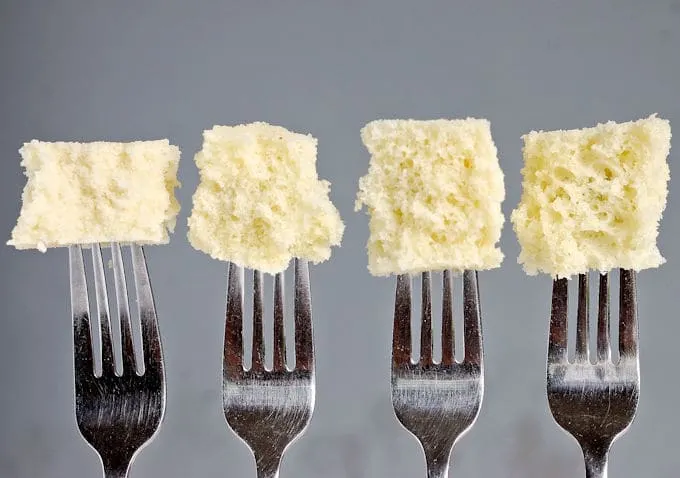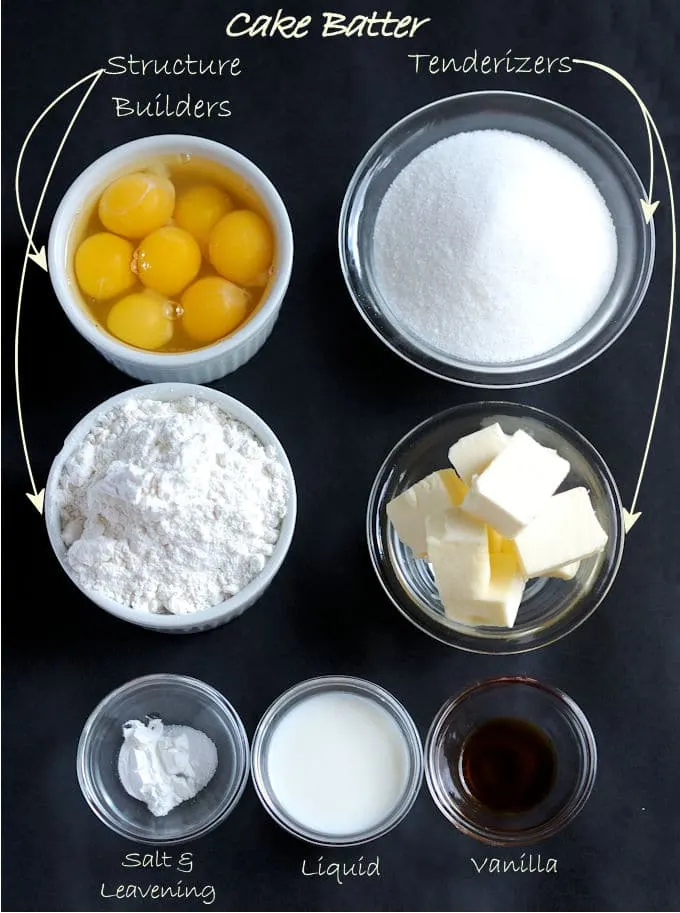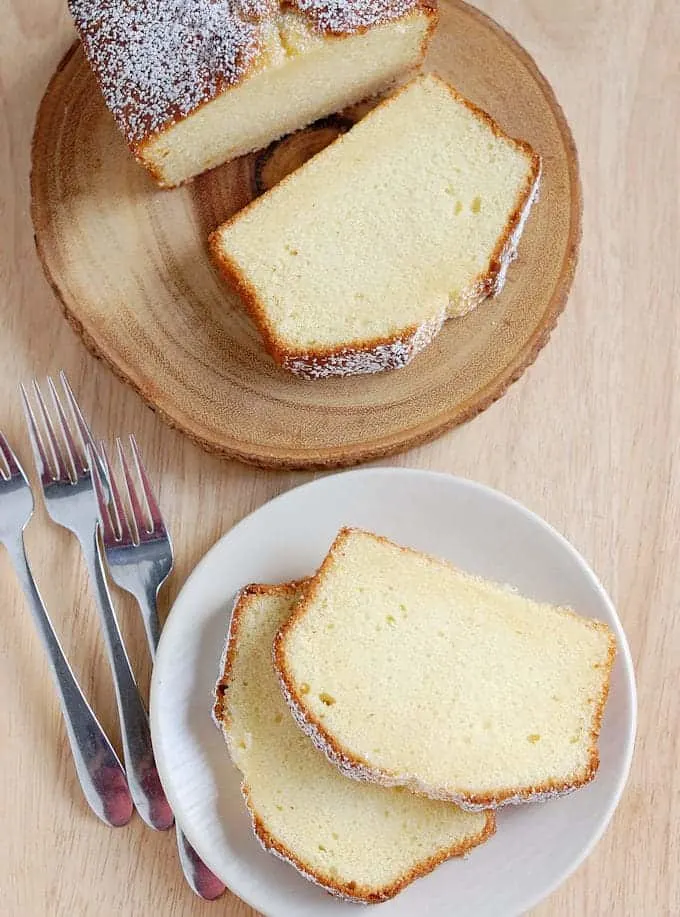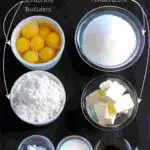How to create the best Cake Recipes
In this article we’ll learn how to create a great cake recipe using the Baker’s Formula.
The information in this article is the culmination of all our Cake Batter classes, but can also stand alone. If you’d like to follow the classes in order visit the Baking School/Science of Cake Batter page.

Use the Baker’s Formula for making the best cakes
To make a perfectly moist and soft cake you’ll first need to understand the concept of the baker’s formula.
A successful cake recipe balances the ingredients that strengthen the cake structure (flour and eggs) with the ingredients that weaken and tenderize the cake structure (sugar and fat).
The Baker’s Formula is used to calculate the proper percentage of each ingredient for a successful recipe. The flour in the recipe is designated at 100% and all the other ingredients are designated relative to the flour. This is a very important point, so keep it in mind as we get deeper into it.

Lean Cakes vs. High Ratio Cakes
About Lean Cakes:
A pound cake recipe made with equal weights of flour, sugar, butter and eggs is a so-called “lean cake”. A “lean cake” has a very simple 1:1 formula balancing the structure-builders with the tenderizers.
The only liquid in the original recipe comes from the eggs (egg whites are 90% water).
About High Ratio Cakes:
While a lean cake is made with equal proportions of flour and sugar, a high ratio cake has a higher proportion of sugar to flour.
In order for a high ratio cake to have good structure we need to adjust some of the other ingredients to keep the cake formula balanced.
Liquid brings together the structure builders and the tenderizers in the batter. The liquid activates the gluten and swells the starch in the flour. The liquid also dissolves the sugar and helps disperse the fat throughout the batter and, of course, provides moisture.
If we use cake flour, with it’s finely ground starch that absorbs extra moisture, we can change the Baker’s Formula to allow for more liquid.
We can also use an emulsifier in the batter to help bind the liquid and fat in the batter. This allows for even more liquid in the recipe, and thus more sugar since you need liquid to dissolve sugar.
A cake made with cake flour and an emulsifying agent can now be higher than 1:1 (sugar:flour) without compromising the structure.

Adjust the Baker’s Percentages for A Better Pound Cake
I used the original quatre quarts pound cake recipe as the basis for all the cake batter classes because the simple 1:1:1:1 ratio makes it very easy to measure changes. So that is the recipe I will use to show you how to use the baker’s formula to improve a cake recipe.
The first step was to lighten the crumb a tiny bit, so I added a little baking powder to the recipe. A pinch of salt and a teaspoon of real vanilla extract were added to enhance the flavor.
Now that the cake was lighter I wanted to sweeten things up a bit. The Baker’s Formula for a high ratio cake allows for up to about 140% of the weight of sugar to flour. I found in my testing that I like pound cake with a ratio of 125% sugar to 100% flour. With this in mind I increased the sugar in the recipe from 8 oz to 10 oz.
I also wanted to add a little extra liquid for moistness, so I needed an emulsifier in the batter. Vegetable shortening will act as an emulsifier, but I prefer an all-butter cake for the unparalleled flavor.
Instead of using shortening in the batter, I used a few extra egg yolks because yolks are great emulsifiers and also add a little extra fat and flavor to the batter. I changed the 8 oz of eggs in the recipe to 3 whole eggs and 4 extra yolks.
Now that we have cake flour and emulsifying eggs yolks in the recipe we can add a little more liquid for additional moisture. I added whole milk as the liquid for a basic pound cake recipe.
The revised recipe makes the perfect melt-in-your-mouth buttery pound cake.
Adjust Baker’s Formula for A Lighter Vanilla Layer Cake
Of course the Baker’s Formula is not only useful for perfecting pound cake recipes. We can continue to test the limits of the structure builders and tenderizers to create a whole world of cake recipes.
I’ll give you another example. As I said, the perfect pound cake should have a dense, buttery texture that doesn’t need any icing at all. But a Vanilla Layer Cake is meant to be filled and iced with frosting. So a great Vanilla Layer Cake should be a little lighter and softer than a pound cake.
As a comparison, let’s look at the Baker’s Percentages for my Pound Cake Recipe vs. my Vanilla Butter Cake Recipe:
| Pound Cake | ||
| Flour | -8 oz | 100% |
| Fat | -9 oz | 112% |
| Sugar | -10 oz | 125% |
| Eggs | -8 oz | 106% |
| Liquid | -7.5 oz (w/eggs) |
| Vanilla Cake | ||
| Flour | -9 oz | 100% |
| Fat | -10.6 oz | 116% |
| Sugar | -12 oz | 133% |
| Eggs | -6.6 oz | 73% |
| Liqui | -12 oz (w/eggs) |
Ok, that’s a lot of information. But lets look at the percentages. (Remember: all percentages are relative to the weight of flour in the recipe.)
By just looking at the percentages you can guess that the vanilla cake will be a little more tender (more sugar and fat), a little sweeter (more sugar) and a little more moist (more liquid) than the pound cake.
The vanilla cake recipe also has more leavening and I whip the whites before adding them to the batter. So the vanilla cake also has a more open and light crumb than the pound cake.
Whew!!! So, all those small changes to the basic formula created a lighter, sweeter and softer cake. That’s just what I want for a cake that will be filled and iced with buttercream.
The takeaway here is that every cake recipe in the universe is some variation on this formula. The type of fat or liquid can change, additional ingredients can be added, but it’s always about the balance between structure and softness.
It’s the variations that create the myriad of cake recipes that we can invent and perfect.


Hello Eileen!
I just happened across you’re post after looking at ways to alter a cake recipe and this makes so. Much. Sense!
One question – I’m from across the pond and we don’t have Cake Flour (not in supermarkets anyway) – do you know what flour combination I would use for either the pound or vanilla cake to make my own cake flour?
Thank you! 🙂
For each cup of cake flour you can use 3/4 cup of all purpose (plain) flour plus 2 tablespoons of corn starch.
@Eileen Gray, Thank you! This is very helpful. Would it be better for me to make my own cake flour, OR could I use pastry flour? I have Bob’s Red Mill Pastry and they say it’s a universal cake/pastry – but I wanted your opinion.
I haven’t tried the Bob’s Red Mill product. The two things I like about cake flour is the low protein content and the fact that it is bleached. Both contribute to a soft cake crumb.
Thanks for sharing this really awesome
Hi Eileen, I wanted to sell cakes commercialy in a small scale. Can I use this receipe if the cake has to stay long.
Thanks ,
Vanessa
Are you asking how long this cake will stay fresh? If so, 1-2 days at room temperature or up to 3 months frozen. Never refrigerate the cake. The freezer is your friend for keeping cakes fresh.
Hi Eileen,
Thank you for this post. I understand the idea of the baker’s percentage, but I don’t quite understand how the modified recipes are considered balanced. Can you please elaborate on this?
Thanks
The point of modifying the recipes is to move the texture of the cake towards your ideal texture. If you want a more tender and softer cake you add more sugar and/or fat. If you want a cake with a more resilient crumb (like sponge cake) you add more eggs, etc. If you read through the entire cake series you’ll see that I start from what is a perfectly “balanced” cake. That is, a cake made with equal amounts of butter-sugar-flour-eggs (pound cake). The trick is to adjust the recipe to taste without throwing the ingredients so far out of balance that the cake fails.
What an amazing set of posts. I’ve always wondered about the difference between the Victoria sponge (basically pound cake) that we all bake in the UK and all the variants of American pound cakes and vanilla cakes.
Your scientific approach to each ingredient was fascinating and so thorough. You must have been sick of pound cake by the end.
Lol, I was a little sick of baking the same recipe over and over. Most of the time it was one or two bites and then into the trash or into the freezer to share.
Hello Ellen, I must say this is very good and I enjoyed it and great deal. It added to my knowledge,thank you so much
I wanted to ask how to know the difference between a cake flour and an all purpose flour.
Read this post all about flour and this post all about flour in cake batter for more information.